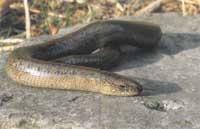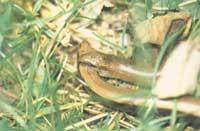The crab, snake that breaks?

Although people who are not immersed in the world of biology may seem the opposite, scientific names often have a clear and expressive meaning. An example of this can be the scientific name of the circus Anguis fragilis. Fragilis, as its specific name indicates, is an animal that can break or lose part of it. This name is very appropriate, since it has the ability to autotomize, that is, release the tail, like the cirrus, lizard and lizards. This way, you can survive certain risk situations and then restore the lost part.
However, the name Anguis used to designate the genus may not be as correct. Anguis is a snake in Latin and the crab is undoubtedly a snake shaped reptile, but with a series of clearly differentiating characteristics of snakes: unlike snakes, the crab has eyelids and can close the eyes; on the other hand, the eardrum containing under the scales is fully developed and, finally, has the ability to partially restore the broken tail. Therefore, what can be broken, but it is not a snake, but a lizard without legs.

Adults rarely have a length exceeding 30-40 cm. More than half of them correspond to the tail, unless they have lost part. The head is similar to that of the lizard, short and with the same thickness of the body, barely separates. Faced with the beliefs of some peoples, this saurian has a lot of vision and is not blind at all. From here, small and dark eyes can detect reddish brown nini and black iris.
The body is long, compact and rigid. Although the circus comes from four-legged ancestors, no trace of the legs appears, which differentiates it from the skis. It is dressed with small smooth and shiny scales, quite variable in colour. Contrary to what is common in reptiles, the female is more colorful than the male. In general, they are antique gold, brown olives, light brown or silver gray. The ribs of the female, the belly and sometimes the column line are darker than those of the female. Juveniles can be distinguished by their smaller size and greater color contrast.
It wants areas with abundant vegetation. We can see it in humid places such as meadows, forest areas or shrubs, and baserritarras often find this reptile working in herbs. It can appear at 2,000 meters above sea level, although in our country it likes average or low altitudes more.

As for the march, it must be said that it is a slowness. If you see yourself in danger, you can hide quickly sliding between the herbs like waves, but normally slowly march. Its typical garrisons are the bottoms of stones, mosses, bushes and rotten logs. Like ophiles, he pulls out the tongue of “smelling”, but he has to open his mouth a little because he doesn’t have the slit that snakes have for it.
Reproduction will occur in spring. After competing with each other, the fastest male will grab the female by the collar and, coiled by the body of both, the pair will join the sewers to complete the dome. Once placed in this way, fertilization will occur by introducing the hemipenea of the male. Between 11 and 13 weeks later, the female will look like 6 to 20 children. This reptile is oboviparous, that is, the eggs are developed internally by the mother, which expand at the time they are laid. Thus, in addition to keeping the eggs at the right temperature, enemies or time manage not to spoil them.
These offspring are between 7.5 and 9 cm at birth and, as already mentioned, are more colorful than adults. They are yellow brown and attract attention the black lines with flanks and back. These babies will be sexually adult 3-4 years later. The survival of these animals is long and it has been confirmed that they can live more than 30 years. Some authors also mention a copy that has lived at home for 54 years.
These angids will be kept in winter to hibernate. To do this, they will pass by land between October and March 4-5 months. They usually choose the natural orifice or one of the micromammals and fall rolled into the lampstand. Sometimes you can spend the winter together by a lot of people of the species and also can do it together with other reptiles or amphibians.

The cirauna is a typically Eurasian species. To the south, Ireland and Europe of the Iberian Peninsula, about 60º parallel to the north, is a well distributed animal throughout the continent and in our region. It is abundant in the Atlantic side of the Basque Country and poorer in the Mediterranean, in the driest places of Álava or Baja Navarra is still smaller.
It is carnivorous in food. It feeds on spades, worms, snails, spiders and insects, showing great calm both when hunting and swallowing. Among its enemies stand out the hedgehog, fox, boar, mustelids, many birds and snakes. And without human beings? We have been able to hear everything. There are those who accuse being a snake and of bad reputation. Many others, fortunately, for being a known and beneficial species, or simply for recognizing that in this world can also live animals in the form of a snake, respects it.
Species: Class: reptiles |





